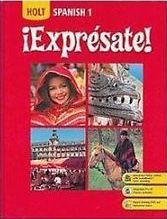
Expresate!: Spanish 1
1st Edition
ISBN: 9780030452048
Textbook solutions
All Solutions
Page 15: 18
Exercise 1
Step 1
1 of 3
In this exercise we’re asked to provide the correct subject pronouns in each blank. The first sentence reads:
“Hello. ____ am Rosalinda Chávez.”
Step 2
2 of 3
We’re asked for the Spanish version of “I”. Even if we weren’t given the English version in the parenthesis, the following verb is *soy*, or the verb *ser* in the first person singular conjugation. That is enough to know we will be using the first person subject pronoun, which you’ll remember from the chart on page 14 is *yo*.
Result
3 of 3
Yo
Exercise 2
Step 1
1 of 3
In this question, we are asked to fill in the blank with the appropriate Spanish translation of the English subject pronoun in the parenthesis. The sentence reads as follows:
“And ____ is my friend Juan.”
The pronoun in the parenthesis is “he”.
Step 2
2 of 3
Since the sentence uses the masculine *amigo*, and Juan is traditionally a male name, we have the context clues to know that the pronoun should be *él*. This is a good way to make sure you really understand the concepts and can look for clues in the sentences, as opposed to just “plugging and chugging”.
Result
3 of 3
él
Exercise 3
Step 1
1 of 3
In this question you are asked to fill in the blank with the appropriate translation of the English pronoun provided in the parenthesis. The sentence reads as follows:
“What is your name _____?”
While the English translation is complete, the Spanish translate asks for the subject pronoun “you” at the end of the sentence.
Step 2
2 of 3
We’ve learned that the sentence *¿cómo te llamas?* is a complete sentence in Spanish. But to be more specific, you could add a subject pronoun to the end of the sentence, much like you would add *él* or *ella* to the end of *¿cómo se llama?* for specificity. We know *¿cómo te llamas?* is the second person singular form (“you” when talking to one person), so the subject pronoun would be *tú*.
Result
3 of 3
Tú
Exercise 4
Step 1
1 of 3
This question asks us to fill in the blanks with the correct subject pronouns based off of the English translations in the parenthesis. The sentence reads:
“My name is Antonia”
Step 2
2 of 3
Much like the last question, this sentence is technically complete, since the conjugation *me llamo* already indicates that the speaker is talking about themselves. But to add specificity or for emphasis, you could add the subject pronoun “yo”, meaning “I”.
Result
3 of 3
Yo
Exercise 5
Step 1
1 of 3
In this question you are asked to supply the correct subject pronoun based on the English translation in the parenthesis. The sentence reads:
“And _____ is my friend Talía.”
Step 2
2 of 3
Although the word in the parenthesis is “she”, we could use context clues to figure out what the correct subject pronoun is, even without the English translation. Our first clue is the word *amiga*, since that is the feminine form of “friend”. Also, the name Talía is traditionally a feminine name in Spanish. According to the chart on page 14, “ella” is how you say “she” in Spanish, in the familiar form, since the speaker is talking about a good friend.
Result
3 of 3
Ella
Exercise 6
Step 1
1 of 3
This question asks you to provide the correct subject pronoun in the blank, based on the English translation in parenthesis. The sentence reads:
“_______(We – Talía and I) are from the United States.”
Step 2
2 of 3
In order to answer this, we have to know the genders of both people that the “we” is referring to, since *nosotros* (“we” in Spanish) has a feminine form. If you’ll recall from the first sentence from this speaker, their name is Antonia, which is a feminine name. We’ve established that Talía would also use feminine pronouns, so the “we” in this case is referring to two girls, meaning we’d use the feminine form, *nosotras*.
Result
3 of 3
Nosotras
Exercise 7
Step 1
1 of 3
In this question you’re asked to provide the correct subject pronouns in the blank, based off of the English translations in parentheses. The sentence reads:
“You and Juan, where are you from?”
Step 2
2 of 3
The English translation we are asked for is the plural form of “you”. Since it isn’t indicated that we should be using the Spanish *vosotros*, we will be using the word *ustedes*, which is the formal and familiar form of “you all”.
Result
3 of 3
Ustedes
unlock

